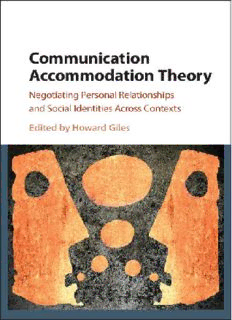
Communication Accommodation Theory: Negotiating Personal Relationships and Social Identities across Contexts PDF
Preview Communication Accommodation Theory: Negotiating Personal Relationships and Social Identities across Contexts
Communication Accommodation Theory Mostpeoplemodifytheirwaysofspeaking,writing,texting,emailing,andso on,accordingtothepeoplewithwhomtheyarecommunicating.Thisfascin- atingbookaskswhywe“accommodate”toothersinthisway,andexplores thevarioussocialconsequencesarisingfromit.CommunicationAccommo- dation Theory (CAT), revised and elaborated over the past forty years, has beenappliedtoawiderangeofsituations,fromfamiliestocourtrooms,and frommediatohospitals,bymeansofdiversemethodologiesinmanydiscip- lines,andacrossnumerouslanguagesandcultures.Bringingtogetherateam ofexperts,thebookdemonstrateshowthetheorycanhelpustowardagreater understanding of interpersonal communication in a multitude of contexts. Finally, it examines the principles of the theory, identifying a range of avenuesalongwhichresearchcanmoveforwardinfuture. howard giles is Distinguished Professor of Communication at the UniversityofCalifornia,SantaBarbaraandHonoraryProfessorintheSchool ofPsychology,UniversityofQueensland,Brisbane,Australia. Communication Accommodation Theory Negotiating Personal Relationships and Social Identities Across Contexts Edited by Howard Giles UniversityPrintingHouse,CambridgeCB28BS,UnitedKingdom CambridgeUniversityPressispartoftheUniversityofCambridge. ItfurtherstheUniversity’smissionbydisseminatingknowledgeinthepursuitof education,learningandresearchatthehighestinternationallevelsofexcellence. www.cambridge.org Informationonthistitle:www.cambridge.org/9781107105829 ©CambridgeUniversityPress2016 Thispublicationisincopyright.Subjecttostatutoryexception andtotheprovisionsofrelevantcollectivelicensingagreements, noreproductionofanypartmaytakeplacewithoutthewritten permissionofCambridgeUniversityPress. Firstpublished2016 AcataloguerecordforthispublicationisavailablefromtheBritishLibrary LibraryofCongressCataloging-in-PublicationData Names:Giles,Howard,1946-editor. Title:Communicationaccommodationtheory:negotiatingpersonalrelationships andsocialidentitiesacrosscontexts/editedbyHowardGiles. Description:Cambridge,UnitedKingdom:CambridgeUniversityPress,[2016]| Includesbibliographicalreferencesandindex. Identifiers:LCCN2016012837|ISBN9781107105829(hardback:alk.paper) Subjects:LCSH:Interpersonalcommunication.|Communicationinsmallgroups.| Communication–Socialaspects.|Groupidentity.|Intergrouprelations.|Social interaction. Classification:LCCHM1166.C6532016|DDC302.3–dc23LCrecord availableathttps://lccn.loc.gov/2016012837 ISBN978-1-107-10582-9Hardback CambridgeUniversityPresshasnoresponsibilityforthepersistenceoraccuracy ofURLsforexternalorthird-partyinternetwebsitesreferredtointhispublication, anddoesnotguaranteethatanycontentonsuchwebsitesis,orwillremain, accurateorappropriate. Contents List of Figures pagevii List of Tables viii Notes onContributors ix Acknowledgments xii 1 The Social Origins of CAT 1 howard giles 2 Theoretical Perspectives on Interpersonal Adjustments in Languageand Communication 13 jessica gasiorek 3 AccommodativeStrategies as Core ofthe Theory 36 marko dragojevic, jessica gasiorek and howard giles 4 Methodsof CAT Inquiry: Quantitative Studies 60 jordan soliz and gretchen bergquist 5 The “DarkSide” of CAT: Nonaccommodation 85 jessica gasiorek 6 CAT and Talk inAction 105 cindy gallois, ann weatherall and howard giles 7 Intergroup Accommodation, Social Categories, and Identities 123 nicholas a. palomares, howard giles, jordan soliz and cindy gallois 8 AccommodatingHealth 152 bernadette m. watson, liz jones and david g. hewett 9 CAT on Trial 169 augusto gnisci, howard giles and jordan soliz v vi Contents 10 Communication Accommodation Theory: Integrations and New FrameworkDevelopments 192 cindy gallois, jessica gasiorek, howard giles and jordan soliz Index 211 Figures 4.1 Frequency of quantitativestudies employing CAT (1973–2015) page 62 7.1 The intergroup process model ofcommunication accommodation theory 142 9.1 Accommodativepathwaysin thecourtroom 178 vii Tables 2.1 Comparison oftheories and constructs of interpersonal adjustment page 20 4.1 Categories for contextsof inquiry 63 4.2 Description ofbehaviorsfor effect size meta-analysis 66 4.3 Categories ofpredictors and outcomesof accommodation behavior from Soliz & Giles (2014) 67 4.4 Meta-analytical data for correlates and group difference 69 viii
Description: